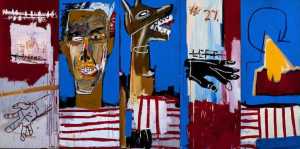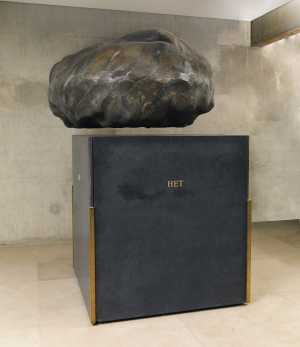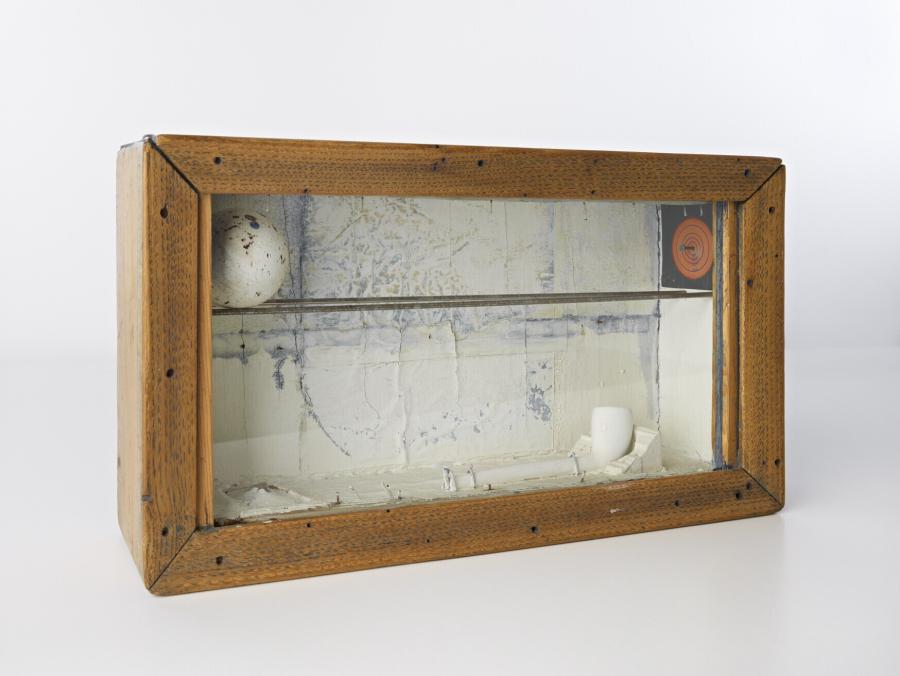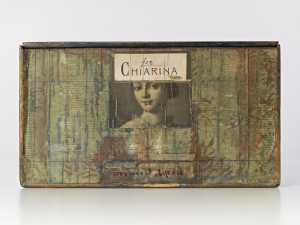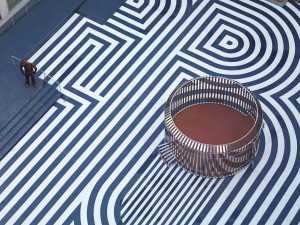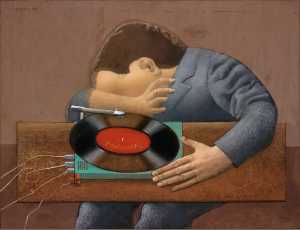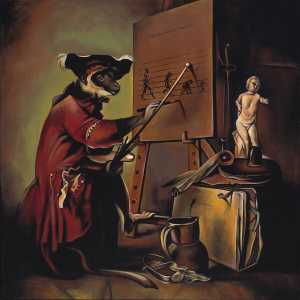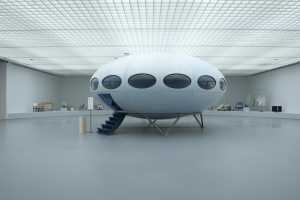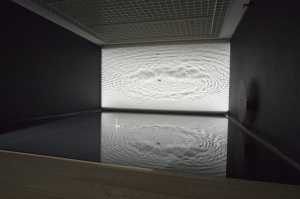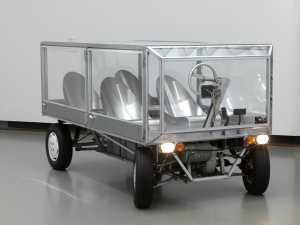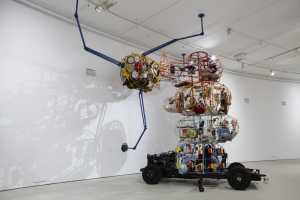Joseph Cornell produced small, box-like objects throughout his life. He would fill these peep-show boxes with all sorts of objects he found in order to create remarkable scenes. This box is one of the Space Object Boxes that he made at the end of the 1950s and which contain references to the universe. The title, For Chiarina, refers to Clara Wieck, pianist, composer and wife of the German composer Robert Schumann. An illustration showing her portrait is on the back of the object. Cornell's work was often inspired by famous women.

Specifications
| Title | Untitled (for Chiarina) |
|---|---|
| Material and technique | Wood, plaster, paper, cork, glass and nails |
| Object type |
Assemblage
> Three-dimensional object
> Art object
|
| Location | This object is in storage |
| Dimensions |
Height 20,3 cm Width 36,2 cm Depth 9,5 cm |
|---|---|
| Artists |
Artist:
Joseph Cornell
|
| Accession number | BEK 1808 (MK) |
| Credits | Purchased with the support of Mondriaan Fund and VriendenLoterij, 2008 |
| Department | Modern Art |
| Acquisition date | 2008 |
| Creation date | in circa 1958 |
| Provenance | L&M Arts, 2008; The Joseph and Robert Cornell Memorial Foundation |
| Exhibitions | Rotterdam 2015a |
| Internal exhibitions |
De collectie als tijdmachine (2017) |
| External exhibitions |
Dal nulla al sogno (2018) Dalí, Magritte, Man Ray and Surrealism. Highlights from Museum Boijmans Van Beuningen (2023) Surrealist Art - Masterpieces from Museum Boijmans Van Beuningen (2021) A Surreal Shock – Masterpieces from Museum Boijmans Van Beuningen (2021) Only the Marvelous is Beautiful (2022) A Surreal Shock. Masterpieces from Museum Boijmans Van Beuningen (2023) |
| Research |
Show research Digitising Contemporary Art Show research A dream collection - Surrealism in Museum Boijmans Van Beuningen |
| Literature | Donker/Reijden/Soons 2016, p. 122; Pieters 2009, p. 15 |
| Material | |
| Object |
Do you have corrections or additional information about this work? Please, send us a message
Entry catalogue Digitising Contemporary Art, A dream collection - Surrealism in Museum Boijmans Van Beuningen
Author: Saskia van Kampen-Prein

Before Joseph Cornell made his name as an artist, he worked as a salesman for a fabric wholesaler in Manhattan.[1] He used his breaks to wander through the city and collect all kinds of things. In his spare time he amassed a large collection of old photographs, celestial charts, feathers, cuttings, compasses, souvenirs and found objects. From the 1930s onwards he incorporated these objects and materials into three-dimensional objects and collages. In the autumn of 1931, after Cornell had seen Max Ernst’s collage book La femme 100 têtes (1929) in the recently opened Julien Levy Gallery in New York, he showed some of his own collages to the young gallery owner. Levy decided to include a number of these works in the trail-blazing group exhibition Surréalisme which he staged in his gallery in January 1932 and which introduced Surrealism to New York. One of Cornell’s fellow exhibitors was Marcel Duchamp, who would become a close friend. In 1942 Cornell would even help him to create various examples of his La boîte-en-valise.[2]
Cornell’s first object was made in 1932 and also featured in the group exhibition in the Julien Levy Gallery. The title was Glass Bell (1932) and it consisted of a glass dome over an assemblage of found objects. In the period that followed, Cornell covered dozens of boxes with printed paper and filled them with shells, beads and found objects. Because the Surrealists were also making objects at that time, Cornell was regarded by many as a Surrealist.[3] At the invitation of museum director Alfred H. Barr Jr, he showed various works at the legendary group exhibition Fantastic Art. Dada, Surrealism (1936-37) in the Museum of Modern Art in New York. One of them was Untitled (Soap Bubble Set) (1936), which he made especially for the occasion. It was the first in a series of ‘Shadow Boxes’, the type of object with which Cornell would primarily make his name. Museum Boijmans Van Beuningen managed to acquire one of these magnificent, hand-made peep-shows in wood and glass in 2008. The work – which Cornell dedicated to the composer and pianist Clara Wieck, whose picture is stuck on the back of the box – was bought from an American gallery which at the time was co-administering the artist’s estate.[4] The box in the museum’s collection has the universe as its theme. In the late 1950s the artist made various Shadow Boxes about the cosmos which he described as ‘Space Object Boxes’. At both ends of the box – which contains a plaster pipe, the base of a wine glass and two thin metal rods with a ball balancing on them – there are the names of the constellations and an astrological chart.
Untitled (for Chiarina) forms a link between the separate collections such as Dada, Pop Art and nouveau réalisme in the museum’s collection. The similarities between Cornell’s Untitled (for Chiarina) and Duchamp’s La boîte-en-valise or the filled archive box Le bleu de la licorne (1973) by the French nouveau réaliste Martial Raysse are obvious.
All about the artist
Joseph Cornell
Nyack 1903 - New York 1972
Joseph Cornell did not follow any artistic training. He became best known for his 'peep shows', which he produced throughout his life. Cornell is a pioneer of...
Bekijk het volledige profiel



